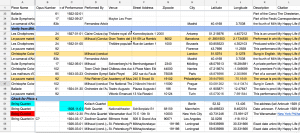You’ve heard us wax poetic about the research process, the glories of mapping, the people and stories we have discovered over the summer, but really you may find yourself wondering: what has this research team accomplished?
First of all, a lot.
Secondly (and more seriously), we’ve learned important things about our own researching abilities and yes, even about Darius Milhaud. At this point in our project, each member of the research team is tackling an individual project. With one of us busy snooping about the Parisian archives, the remaining three of us have been tackling a review of Darius Milhaud’s letters, the creation of a document tracking all of Darius Milhaud’s travels, and final curation and cleaning of the data in our performance database.
I am the Database Queen
I have been looking at this spreadsheet for so long, my eyes are starting to go a bit numb. But usually at this point is when I make some sort of unlikely find, or interpret the data we have gathered in a new way. To tackle to the polishing of the database, I have three major tasks:
- Cleaning data.
- Finding missing information.
- Verifying suspicious information.
Cleaning the data has turned into a semi-therapeutic ritual. There’s something inherently satisfying about seeing all of the cells you’ve just formatted line up like hundreds of tiny soldiers, each standing resolutely in its correctness. I still have some squirrely data to track down, but in the meantime, I’ve ensured that every piece has an Opus Number attached to it, that each column in our spreadsheet is formatted according to the Musical Geography Style Guide. For numbers two and three on my list, I have created a separate tab in our spreadsheet that lays out performances that are unconfirmed in two sources or that are missing any data and go through those performances one by one, tracking down as much of the missing information I can.
In my arsenal, I have the digitized archives of historical newspapers from Germany, Switzerland, Austria, New York, and London in addition to archives from famous orchestras and opera houses. Luckily, I’ve been able to find and verify a large amount of information when I use these sources and cross-reference them with each other. It doesn’t always work out that way. Let me tell you a story.
The Mysterious Case of the Copyright
I was searching for a performance of Le Pauvre Matelot that supposedly occurred in Florence, Italy, I had searched high and low, reading the international section of archived newspapers from New York and Germany. Eventually, I decided to go looking for a digitized database of Italian historical newspapers. It was a last ditch effort; I was doubtful that there would be an archive of historical newspapers online. However, after combing through a page or two of Google Results, there it was. The National Library of Rome had periodicals! The website even said they were digitized! But when I tried to click on an article that mentioned Milhaud, this message popped up:
“Due to copyright restrictions, this material is unavailable in your country.”
I just about threw my computer across the room. (I did not). (Barely).
This exact scenario has happened more times than I care to remember, but it usually gets me somewhere. For example, in my quest for Italian Historical newspapers, I was able to find a collected database from Eurodocs that lists several other digitized collections of newspapers that I can check out later. There’s always a silver lining!
And now?
My work on our Performance Database has helped us produce maps, like the one you see below.
My next task is continuing to clean and refine the spreadsheet as more performances are being added, and to brainstorm all of the possible layers that may be needed so that I can prepare to export them from our database into ArcGIS. I’m looking forward to the continued analysis of our data for musical trends.

You must be logged in to post a comment.